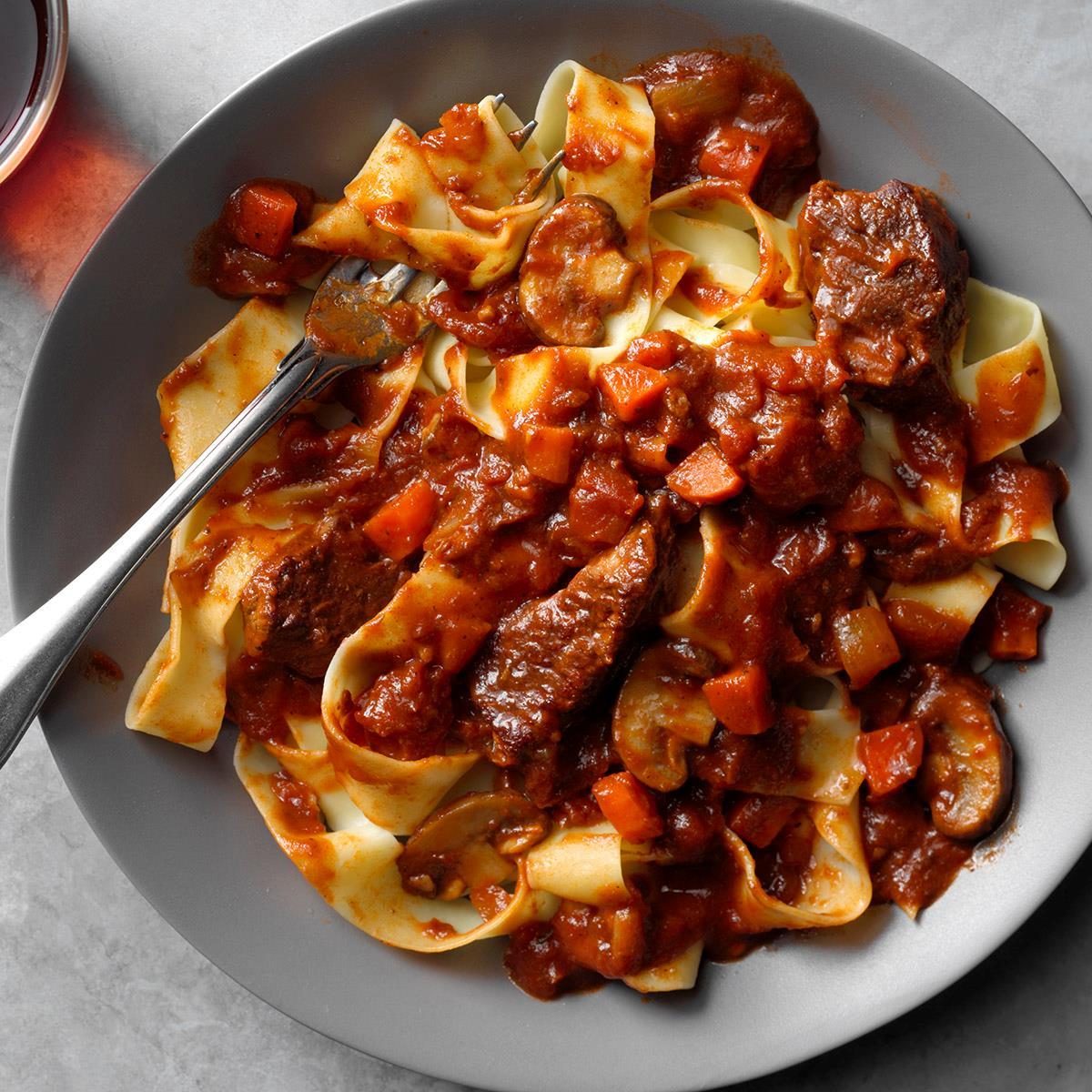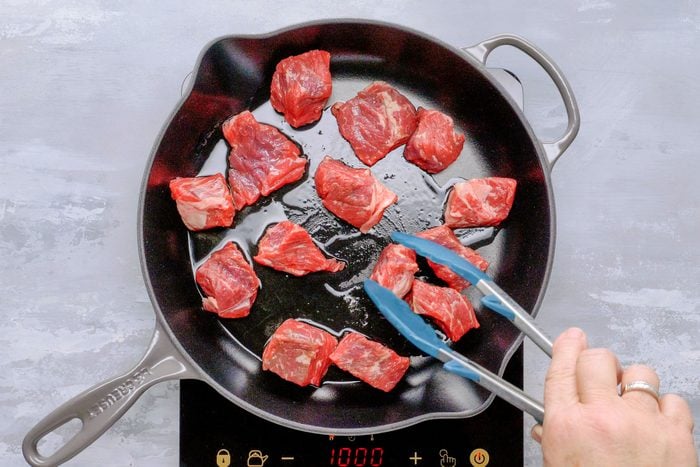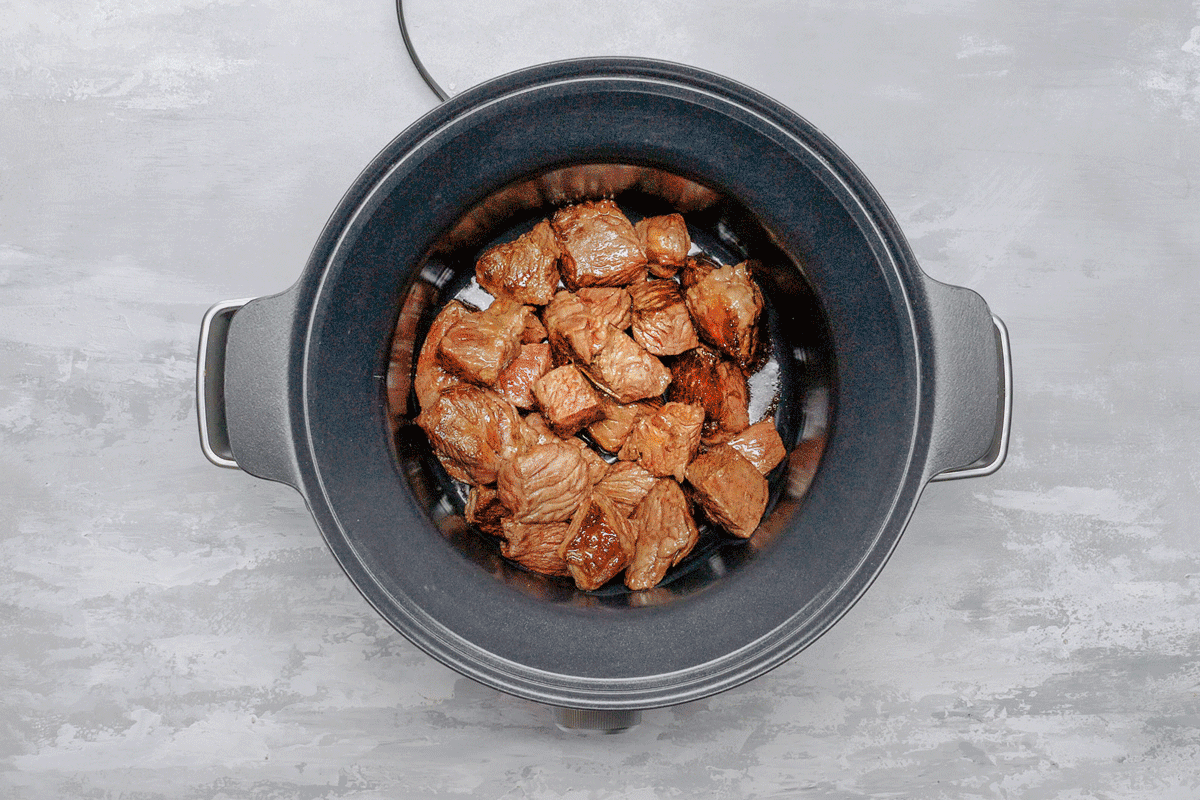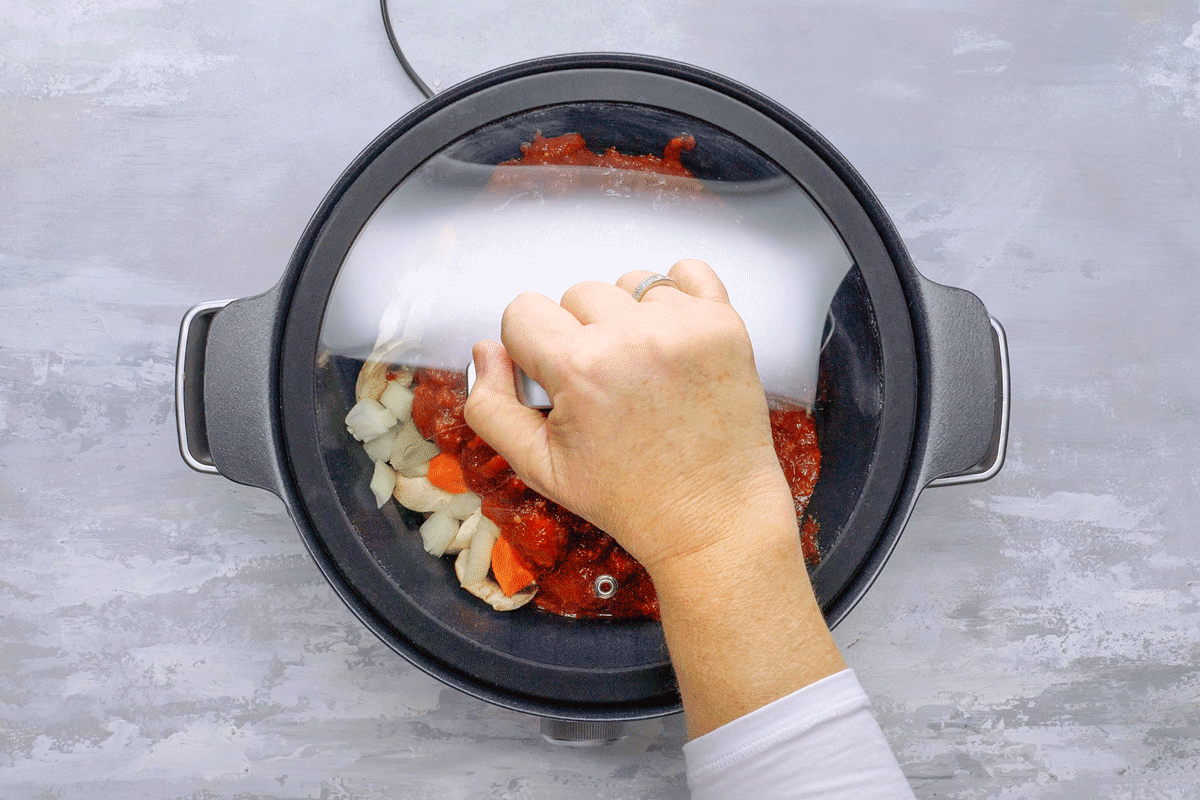This rich, hearty short rib ragu is made in the slow cooker. The tomato-wine sauce is decadent, and the short ribs are so tender you can cut them with a fork.

Short Rib Ragu

This short rib ragu is the perfect recipe for your next date night or special occasion. It’s simple to prepare yet tastes deep, rich and complex, thanks to the slow cooker. The bold, hearty dish features tender chunks of short ribs swimming in a rich tomato-wine sauce. It will fill the house with an incredible aroma as it cooks! Short rib ragu is traditionally served over pappardelle pasta, but it tastes equally delicious over gnocchi, polenta or mashed potatoes.
The slow cooker is a fantastic hands-off cooking method for making all sorts of slow-cooker beef recipes. The low-and-slow cooking method excels at transforming tough cuts of meat (like short ribs) into fall-apart, tender bites. We don’t recommend putting frozen meat in a slow cooker, though, so make sure you start with thawed short ribs.
What is ragu?
Ragu is a rich Italian meat sauce that’s usually served over pasta. Ragu comes in many forms, and you may have heard about one popular version from Italy’s Bologna region: ragu Bolognese. Ragu sauces are made by simmering meat (typically beef, pork or game) in a flavorful braising liquid (often tomato or wine-based) over low heat until nice and tender.
Short Rib Ragu Ingredients
- Boneless beef short ribs: Short ribs come from a section of beef known as the plate rib. It can be a tough meat if not cooked properly because it contains a lot of collagen-rich connective tissue. It takes a long time for connective tissue to break down, so it must be cooked over low heat, typically for hours. Over time, the meat becomes tender and releases gelatin, enriching the ragu with incredible body.
- Mushrooms: Mushrooms add an umami boost to this rich sauce. They become super soft and tender over the long braise. You can use white button mushrooms or cremini mushrooms, which taste a little more complex.
- Carrots: Carrots bring sweetness to the dish to balance the acidity of the tomatoes. Some carrots are sweeter than others, so you can adjust the sweetness at the end with a pinch of sugar if it’s too acidic (or a dash of vinegar if it’s too sweet).
- Tomato paste: A whole 12-ounce can of tomato paste may sound like a lot, but it isn’t a typo! Tomato paste has been cooked until almost all the water evaporates, so it’s very concentrated. Combined with a can of undrained diced tomatoes, it’s responsible for the sauce’s rich tomato flavor.
- Red wine: Red wine deepens the tomato flavor in this rich ragu. If you don’t have wine on hand, feel free to substitute white wine or beef broth.
- Crushed red pepper flakes: This fiery spice adds a touch of heat to the sauce. You can adjust the quantity based on your spice tolerance.
- Pappardelle: Pappardelle are wide, flat noodles, and they’re perfect for hearty sauces. Fettuccine or tagliatelle work well, too.
Directions
Step 1: Brown the beef short ribs

In a large skillet, heat the oil over medium-high heat. Brown the short ribs in batches, transferring the browned pieces to a 5- or 6-quart slow cooker as they finish.
Editor’s Tip: Giving the meat plenty of space is important. Otherwise, you can overcrowd the pan, and the meat will steam instead of caramelize. That would rob you of that gorgeous golden-brown color!
Step 2: Add the vegetables to the slow cooker

Add the mushrooms, onion, carrots and bay leaves to the slow cooker.
Step 3: Make the sauce

In the same skillet, add the tomato paste, wine, garlic, Italian seasoning, crushed red pepper flakes, salt and pepper. Cook, stirring, over medium heat until fragrant and slightly darkened, two to four minutes. Add the diced tomatoes, and stir until blended.
Editor’s Tip: You could mix these ingredients together in a bowl, but briefly cooking them enhances their flavors. It also deglazes the skillet, incorporating the fond (read: pan drippings) into the sauce.
Step 4: Slow-cook the beef

Transfer the sauce to the slow cooker. Cover and cook on low until the beef is tender, seven to nine hours. Discard the bay leaves.
Editor’s Tip: The beef should cook up nice and tender, but in case it doesn’t, here’s how to fix tough meat in the slow cooker.
Step 5: Serve with pasta
Cook the pappardelle pasta according to the package directions for al dente. Spoon the ragu over the pasta. If desired, serve with Parmesan cheese.
Editor’s Tip: If the sauce is too thick, adjust the consistency with a splash of beef broth. Or swirl in a little milk or heavy cream to give it a creamy, velvety texture.
Recipe Variations
- Add a Parmesan rind: We save our Parmesan rinds and add them to soups, stews and sauces. The rind adds another element of richness to this incredible ragu.
- Include herbs: Add thyme or rosemary to the sauce as it slow-cooks, or finish the dish with a sprinkle of chopped fresh parsley or oregano.
- Balance with sweetness: Tomatoes are naturally acidic. You can balance the sauce as needed with a touch of sugar or honey. Sweetness comes in many forms, so you could also use heavy cream, butter or caramelized onions for a similar effect.
- Top it with burrata: Add richness to richness by topping each plate with a small ball of burrata cheese. This creamy cheese is also a great way to tame the heat if it’s too spicy, and it can also work to balance the acidity.
- Use a pressure cooker: Running short on time? Learn how to convert a slow cooker for the Instant Pot.
How to Store Short Rib Ragu
It’s best to store short ragu separately from the pasta. Let the ragu cool completely, then store it in an airtight container in the refrigerator for up to four days. Reheat the ragu on the stovetop over medium heat until it reaches 165°, adding a splash of water or broth as needed to adjust the consistency.
For more extended storage, freeze the sauce in freezer-safe containers for up to six months. Let the ragu thaw in the refrigerator overnight before reheating.
Can you make short rib ragu ahead of time?
Yes, short rib ragu can be made up to four days in advance. In fact, the sauce may taste better the next day, as time gives the flavors a chance to better meld together.
Short Rib Ragu Tips
What is the best cut of meat for a ragu?
Beef short ribs are very flavorful, but you can make ragu with several other types of meat. Numerous kinds of ragu use pork, duck, lamb and even poultry. You could use boneless country-style pork ribs, or stick to beef and use cuts such as brisket or chuck roast.
You could also make this recipe with bone-in beef short ribs, although the bone-in cuts are better suited for beef entrees like braised short ribs. Flanken-cut (cut across the ribs, so there are multiple small ribs per piece) short ribs are typically used for Korean barbecue. English-cut (cut lengthwise, so there is one long rib bone per piece) short ribs are meatier, so we like them for recipes like saucy slow-cooker short ribs.
What else can you serve with short rib ragu?
We serve this short rib ragu over pappardelle pasta, but several side dishes pair well with this rich, delicious sauce. You can use other types of pasta (even zucchini noodles), or opt for creamy polenta, gnocchi, spaetzle dumplings or mashed potatoes.
Do you have to brown the short ribs when making ragu?
We strongly recommend browning the short ribs when making short rib ragu. The process of browning achieves something called the Maillard reaction, where the proteins and sugars in food caramelize, creating hundreds of flavor compounds in your food. Additionally, browning the meat before using it will add a depth of color to the finished ragu.
What kind of red wine should you use to make short rib ragu?
For making short rib ragu, we recommend a dry red wine like cabernet sauvignon, merlot or a red blend. Worried about wasting the unused wine? Boxed wine is a fantastic option. You can pour just what you need, and the rest will stay sealed and fresh in your pantry for next time.
Watch How to Make Short Rib Ragu
Short Rib Ragu
Ingredients
- 1 tablespoon olive oil
- 2 pounds boneless beef short ribs, cut into 2-inch pieces
- 8 ounces sliced mushrooms
- 1 small onion, chopped
- 2 small carrots, peeled and chopped
- 2 bay leaves
- 1 can (12 ounces) tomato paste
- 1/2 cup dry red wine
- 3 garlic cloves, minced
- 1 tablespoon Italian seasoning
- 1 teaspoon crushed red pepper flakes
- 1/2 teaspoon salt
- 1/2 teaspoon pepper
- 1 can (28 ounces) diced tomatoes, undrained
- 1 pound pappardelle
- Parmesan cheese, grated or shaved, optional
Directions
- In a large skillet, heat oil over medium-high heat; brown meat in batches. Transfer meat to a 5- or 6-quart slow cooker. Add mushrooms, onion, carrots and bay leaves.
- In the same skillet, add tomato paste, wine, garlic and seasonings. Cook and stir over medium heat until fragrant and slightly darkened, 2-4 minutes. Stir in diced tomatoes until blended. Transfer mixture to slow cooker; cover. Cook on low until beef is tender, 7-9 hours. Discard bay leaves.
- Cook pasta according to package directions for al dente. Serve ragu over pasta. If desired, serve with Parmesan cheese.
Nutrition Facts
3/4 cup ragu over 3/4 cup pasta: 302 calories, 8g fat (3g saturated fat), 31mg cholesterol, 328mg sodium, 39g carbohydrate (7g sugars, 4g fiber), 18g protein.




















